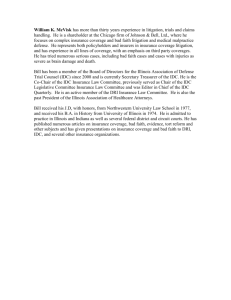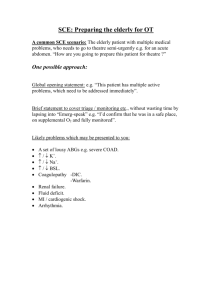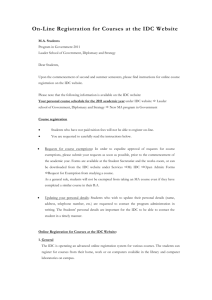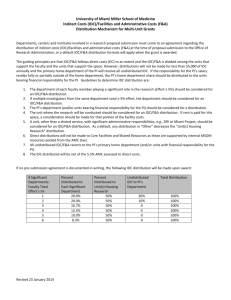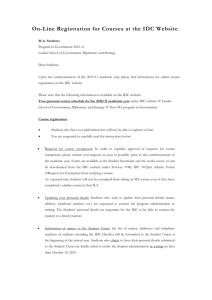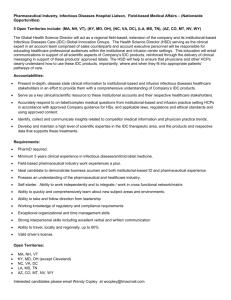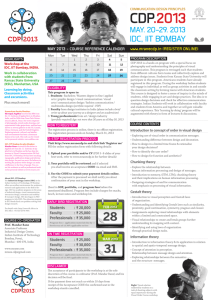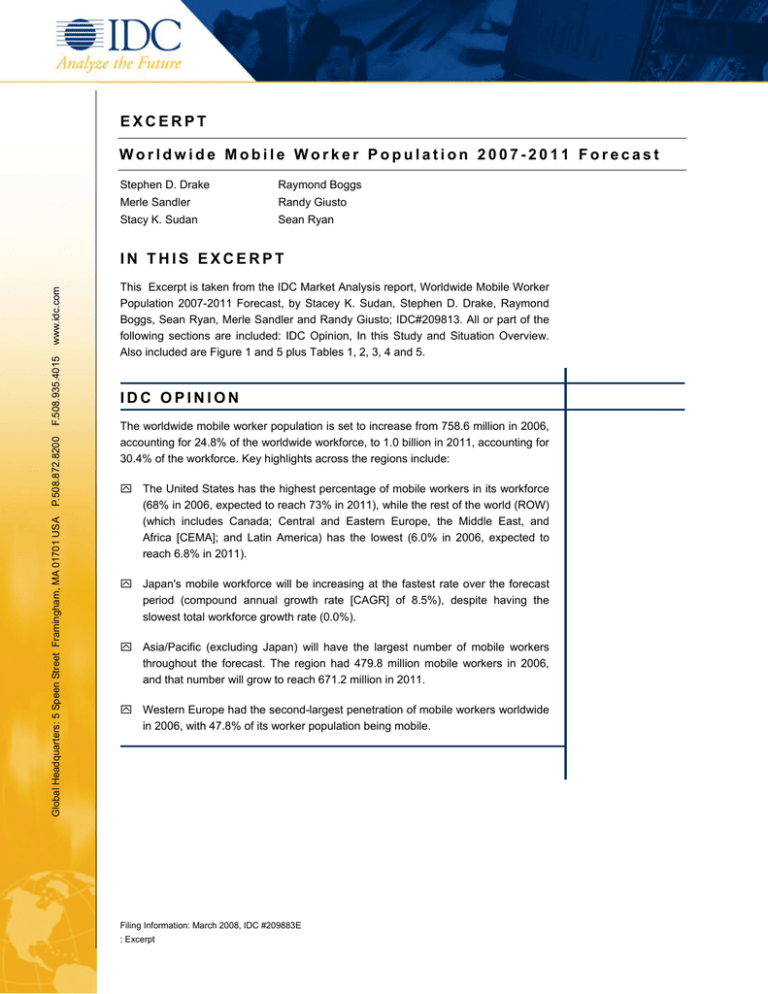
EXCERPT
Worldwide Mobile Worker Population 2007-2011 Forecast
Stephen D. Drake
Raymond Boggs
Merle Sandler
Randy Giusto
Stacy K. Sudan
Sean Ryan
Global Headquarters: 5 Speen Street Framingham, MA 01701 USA
P.508.872.8200
F.508.935.4015
www.idc.com
IN THIS EXCERPT
This Excerpt is taken from the IDC Market Analysis report, Worldwide Mobile Worker
Population 2007-2011 Forecast, by Stacey K. Sudan, Stephen D. Drake, Raymond
Boggs, Sean Ryan, Merle Sandler and Randy Giusto; IDC#209813. All or part of the
following sections are included: IDC Opinion, In this Study and Situation Overview.
Also included are Figure 1 and 5 plus Tables 1, 2, 3, 4 and 5.
IDC OPINION
The worldwide mobile worker population is set to increase from 758.6 million in 2006,
accounting for 24.8% of the worldwide workforce, to 1.0 billion in 2011, accounting for
30.4% of the workforce. Key highlights across the regions include:
The United States has the highest percentage of mobile workers in its workforce
(68% in 2006, expected to reach 73% in 2011), while the rest of the world (ROW)
(which includes Canada; Central and Eastern Europe, the Middle East, and
Africa [CEMA]; and Latin America) has the lowest (6.0% in 2006, expected to
reach 6.8% in 2011).
Japan's mobile workforce will be increasing at the fastest rate over the forecast
period (compound annual growth rate [CAGR] of 8.5%), despite having the
slowest total workforce growth rate (0.0%).
Asia/Pacific (excluding Japan) will have the largest number of mobile workers
throughout the forecast. The region had 479.8 million mobile workers in 2006,
and that number will grow to reach 671.2 million in 2011.
Western Europe had the second-largest penetration of mobile workers worldwide
in 2006, with 47.8% of its worker population being mobile.
Filing Information: March 2008, IDC #209883E
: Excerpt
IN THIS STUDY
Definitions
IDC segments the mobile worker population into three core categories, which include
office-based mobile workers, non-office-based mobile workers, and home-based
mobile workers. Within each of these categories, IDC further segments the mobile
workers (see Figure 1). The following sections provide definitions for each category
and subcategory of mobile worker.
FIGURE 1
Mobile Worker Population Hierarchy
Mobile workers
Mobile
workers
Non-office-based
mobile workers
Office-based
mobile workers
Home-based
mobile workers
Mobile
home-based
business workers
Telecommuters
Mobile
field workers
Mobile
on-location
workers
Mobile professionals
(telecommuters)
Mobile professionals
(home business)
Occasionally mobile
(home business)
Occasionally mobile
(telecommuters)
No traveling
(telecommuters)
Mobile
professionals
Occasionally
mobile
Mobile nontravelers
(office)
Source: IDC, 2007
Mobile Workers
Mobile workers can be divided into three mutually exclusive main categories: officebased mobile workers, non-office-based mobile workers, and home-based mobile
workers.
Office-Based Mobile Workers
Office-based mobile workers are those whose primary workplace is the office. This
category includes mobile professionals, occasionally mobile workers, and mobile
nontravelers.
2
#209883E
©2008 IDC
Mobile Professionals
Mobile professionals are employees that are away from t heir primary workplace
20% or more of the time. These employees are typically made up of traveling
executives, consultants, sales reps, insurance agents, pharmaceutical reps, and
others, such as those in the healthcare industry. Mobile professionals are considered
to be travelers when they are between locations and visitors when they arrive.
Occasionally Mobile
Previously known as the mobile migration opportunity, occasionally mobile workers
are those who may be involved in some mobile activity outside of their primary
workplace but do not fit the criteria of mobile professionals who are away from their
office at least 20% of the time. These employees may only be mobile a few times a
year or less than 20% of their workdays per month.
Mobile Nontraveler
Mobile nontravelers are those workers who are mobile within the office or campus
environment but do not travel outside of the office or campus. An example would be
IT professionals who travel within buildings and campuses to assist in administration
of networks and PCs but are not considered to be mobile professionals or
occasionally mobile workers as defined because their mobility pattern remains within
the office or campus environs.
Non-Office-Based Mobile Workers
Non-office-based mobile workers are those workers who are mobile but are not in an
office environment. The two types of mobile non-office-based workers include mobile
field workers and mobile on-location workers.
Mobile Field Workers
Formerly known as mobile data collectors, mobile field workers are typically field
service employees from various vertical industries who collect data or require twoway data while out in the field. Increasingly, these employees are delivering
enhanced services beyond data collection (such as sales functions) to better serve
clients' needs and provide an upsell opportunity for the company.
Workers move from location to location and include those in typically service-oriented
fields such as transportation, package delivery, trucking, route accounting, utilities,
HVAC, construction management, and warehousing logistics. What makes mobile
field workers unique is their pattern of mobility. The locations to which they travel may
be part of a regularly traveled route or may vary from day to day. For example, a
driver for a package delivery service may drive the same route every day.
Conversely, a field service employee's route may be determined at the beginning of
each day based on a list of scheduled service calls or may change throughout the day
as service calls are received. Mobile field workers often, but not always, operate a
company vehicle as part of their job.
Mobile On-Location Workers
Mobile on-location workers are those employees that work at a specific location but
outside of an office environment. Unlike mobile field workers, these employees are
typically mobile only within a specific area, as they are on location at their primary
©2008 IDC
#209883E
3
workplace. Mobile on-location workers may work indoors (e.g., in a restaurant or
warehouse), outdoors (e.g., at a construction site), or in mixed environments.
Examples include warehouse workers, hospitality workers, and rental car employees
assisting customers who are picking up and dropping off vehicles. Some may operate
specialty equipment (e.g., forklifts and construction equipment) as part of their job.
Home-Based Mobile Workers
Home-based mobile workers are those mobile and remote workers who use their
home as a workplace all or part of the time. This category includes telecommuters
and mobile home-based business workers.
Telecommuters
Telecommuters are corporate employees who work at home during normal business
hours. The threshold for telecommuters is three days a month or more, though some
telecommuters may spend no time in traditional offices. (In effect, they are
telecommuting full time.) These workers may have an informal arrangement between
the employee and the supervisor, or the work arrangement can be more formalized
with a written policy and enrollment.
Telecommuters consist of the following:
Mobile professionals (telecommuters): This segment consists of those
telecommuters who also travel away from their homes or corporate offices at
least 20% of the time. This definition is consistent with office-based mobile
professionals, with the only distinction being that these employees work out of
their homes three days a month or more. An example would be regional
salespeople who, because of their territory (e.g., the northeastern United States),
may report to corporate offices but, because of logistics, work out of their homes
and travel within their regional sales territories, visiting clients and prospects.
Occasionally mobile (telecommuters): This segment consists of
telecommuters who may be involved in some mobile activity outside of their
primary workplace but do not fit the criteria of mobile professionals who are away
from their offices at least 20% of the time. These employees may be mobile only
infrequently. This definition is consistent with that of office-based occasional
mobile workers, with the only distinction being that these employees are
telecommuters. An example here would be the worker who telecommutes
occasionally for business or personal reasons and has a tendency to travel
occasionally to clients or other offices.
Nontraveling telecommuter: Nontraveling telecommuters are workers who are
considered to be mobile by virtue of being telecommuters but do not travel away
from the home or the corporate office. An example would be a finance
department employee who telecommutes a particular number of days because of
personal or professional reasons and only works from home or the main office
and does not travel for business purposes.
Mobile Home-Based Business Workers
Mobile home-based business workers consist of those home-based, incomegenerating business owners who are the following:
4
#209883E
©2008 IDC
Mobile professionals (home business): Mobile professional (home business)
workers are those home-based business owners and employees whose primary
workplace is a home and who are away from their primary workplace at least
20% of the time.
Occasionally mobile (home business): Occasionally mobile (home business)
workers are those home-based business owners and employees whose primary
workplace is a home and who are away from their workplace less than 20% of
the time. They may only be mobile a few times a year.
Other Types of Mobile Workers
IDC identifies a number of additional categories of mobile workers that are essentially
an overlay of the categories defined previously. IDC does not quantify these
categories separately but uses them largely to further qualify and detail the core
mobile workers.
Travelers
Travelers are mobile professionals or occasionally mobile workers, home and office
based. They are defined as travelers at the specific time when they are in transit in a
plane, train, airport, train station, etc. Travelers are on their way to their final
destination, which may be a hotel, conference center, client site, or satellite office, or
are on the return journey. Travelers differ from commuters; commuters are en route to
the office, but travelers are on their way to or from a visitor site.
Visitors
Visitors are travelers who have reached their destination, which may be a hotel,
conference center, client site, or satellite office. At the point at which mobile workers
become visitors, they have reached a certain level of "fixed" mobility in so much as
they are mobile because they are away from the office, but unlike travelers, they are
much less transient.
Commuters
IDC recognizes that the majority of the U.S. workforce commutes to some extent from
where they live to where their workplace is located and back home (exceptions
include full-time telecommuters and home-based business owners). IDC is interested
in those commuters who are leveraging some mobile device technology on their way
to work or returning. Like the traveler, the commuter is very transient in nature, but
unlike the traveler, who may spend a day or more traveling and is typically in different
locations, the knowledge-working commuter has a much shorter traveling time (from
minutes to several hours) and is typically traveling the same route each day. The
means of traveling is often very similar (e.g., takes the subway to work every day) and
typically very limited (e.g., car, subway, or bus).
Corridor Cruisers
Corridor cruisers include those office-based employees that travel within the office or
campus area. Corridor cruisers include mobile nontravelers as well as a percentage
of office-based mobile professional and occasionally mobile workers, who may exhibit
this work pattern at certain times.
©2008 IDC
#209883E
5
Work Extenders
This segment includes corporate workers who take work home from traditional jobs
after normal business hours. Although they work in the evening or on weekends,
corporate after-hours employees are not compensated separately. Their reward
would likely come through raises and promotions associated with greater productivity.
Geographic Definitions
IDC includes five regions in this study: the United States, Western Europe,
Asia/Pacific (excluding Japan), Japan, and ROW.
Countries in the Western Europe forecast include Austria, Belgium, Denmark,
Finland, France, Germany, Greece, Ireland, Italy, Netherlands, Norway, Portugal,
Spain, Sweden, Switzerland, and the United Kingdom.
Countries in Asia/Pacific (excluding Japan) include Australia, China, Hong Kong,
India, Indonesia, Korea, Malaysia, New Zealand, Philippines, Singapore, Taiwan,
Thailand, Vietnam, and the rest of Asia/Pacific (ROAP).
The ROW region includes Canada; Central and Eastern Europe, the Middle East, and
Africa (CEMA); and Latin America.
Worldwide Workforce by Segment
Tables 1 and 2 and Figure 5 segment the overall worldwide worker population and
the worldwide mobile worker population for the forecast period.
IDC predicts that the mobile worker population worldwide will amount to 1.0 billion
people in 2011, up from 758.6 million in 2006. This represents a CAGR of 5.8%. In
addition, the mobile worker population's share of the total workforce worldwide is
expected to increase from 24.8% in 2006 to 30.4% in 2011.
Segmenting the forecast numbers by the three main mobile worker categories reveals
the following:
Mobile office workers. This group represents the lion's share of the mobile
workforce population (62.3% in 2006 and 62.0% in 2011). This segment will grow
from 472.7 million in 2006 to 622.9 million in 2011, increasing at a CAGR of
5.7%.
Mobile nonoffice workers. This segment will experience the highest growth rate
during the forecast period (CAGR of 6.2%), while representing the secondlargest share of the population (31.7% in 2006 and 32.3% in 2011).
Home-based mobile workers. This group will reach 58.0 million worldwide by
2011, up from 45.4 million in 2006, with a CAGR of 5.0%.
6
#209883E
©2008 IDC
TABLE 1
Worldwide Worker Population by Segment, 2006–2011 (M)
2006
2007
2008
2009
2010
2011
758.6
801.1
847.8
896.5
947.8
1,005.4
Growth (%)
NA
5.6
5.8
5.7
5.7
6.1
Share (%)
24.8
25.7
26.8
27.9
29.0
30.4
2,303.7
2,315.5
2,319.1
2,320.1
2,318.3
2,306.3
Growth (%)
NA
0.5
0.2
0.0
-0.1
-0.5
Share (%)
75.2
74.3
73.2
72.1
71.0
69.6
3,062.3
3,116.7
3,167.0
3,216.6
3,266.1
3,311.6
NA
1.8
1.6
1.6
1.5
1.4
Mobile
Nonmobile
Total
Growth (%)
2006–2011
CAGR (%)
5.8
0.0
1.6
Note: See Table 3 for key forecast assumptions.
Source: IDC, 2007
TABLE 2
Worldwide Mobile Worker Population by Segment, 2006–2011 (M)
2006
2007
2008
2009
2010
2011
2006–2011
CAGR (%)
472.7
498.7
527.6
556.7
588.3
622.9
5.7
Growth (%)
NA
5.5
5.8
5.5
5.7
5.9
Share (%)
62.3
62.3
62.2
62.1
62.1
62.0
240.5
254.7
269.8
286.7
304.0
324.4
Growth (%)
NA
5.9
5.9
6.2
6.0
6.7
Share (%)
31.7
31.8
31.8
32.0
32.1
32.3
45.4
47.7
50.5
53.1
55.4
58.0
Growth (%)
NA
4.9
5.8
5.3
4.2
4.7
Share (%)
6.0
6.0
6.0
5.9
5.8
5.8
758.6
801.1
847.8
896.5
947.8
1,005.4
NA
5.6
5.8
5.7
5.7
6.1
Mobile office
Mobile nonoffice
Mobile home based
Total
Growth (%)
6.2
5.0
5.8
Note: See Table 3 for key forecast assumptions.
Source: IDC, 2007
©2008 IDC
#209883E
7
FIGURE 5
Worldwide Mobile Workforce Penetration by Region,
2006 and 2011
Asia/Pacific
United States
Western Europe
ROW
Japan
Total
0
20
40
60
80
100
(%)
2006
2011
Source: IDC 2007
Forecast Assumptions
Key forecast assumptions are discussed in detail in Table 3. In developing forecast
assumptions, IDC considers three specific factors: the level of impact that the
assumption will have on the market (high, moderate, low), whether the assumption
will act as an accelerator or inhibitor, and the certainty of the assumption.
8
#209883E
©2008 IDC
TABLE 3
Key Forecast Assumptions for the Worldwide Mobile Worker Population,
2007–2011
Market Force
Accelerator/
Inhibitor/
Neutral
IDC Assumption
Impact
Industrialized regions that
experience long-term economic
growth will be more prone to
consider investments in
corporate mobile technology
infrastructure and devices. The
world economy has been
experiencing strong growth, but
signs of market risk exist in
rising oil prices, the declining
U.S. dollar, and the subprime
lending debacle in the United
States.
Moderate. Strong GDP growth
in many countries has put many
companies in a position to
spend on mobility, but this will
be tempered by market
uncertainties.
Demographic/
workforce growth
Steady growth is expected in
Asia/Pacific (excluding Japan)
and ROW. Slow workforce
growth is expected in mature
markets.
High. Mobile solutions/products
will be easier to sell to a young,
tech-savvy workforce.
Globalization
Multinational corporations and
corporations doing business
with partners or customers in
other regions will have a higher
likelihood of having mobile
workers due to time differences
and cross-pollination of
business practices.
Low. This will help to
accelerate adoption of mobility
in Asia/Pacific (excluding
Japan) and ROW. It also will
act as a driver for greater
adoption in the United States
and Western Europe.
Corporations are exploring
more seriously the advantages
of telecommuting as a way to
reduce corporate space leasing
expenses.
Moderate. Country-specific
attempts will be made at this
time in the United States,
Western Europe, Canada, and
some parts of Asia.
↔
Newer models with stronger
capabilities, multiple
connectivity options, and a
variety of form factors will
continue to proliferate.
Downward pressure on price
will continue.
High. Mobile devices that are
better designed to meet the
needs of mobile workers of all
types and at reasonable price
points will enable a greater
number of workers to become
mobile.
↑
Strong penetration of enterprise
wireless LAN deployments will
occur in organizations
High. A solid infrastructure and
data and content delivery
venue will build market
Certainty of
Assumption
Macroeconomics
Worldwide
economic growth
Pressure to
optimize corporate
revenue through
cost savings
↑
↔
↑
Technology
Mobile devices
Services/platform/
infrastructure
©2008 IDC
#209883E
↑
9
TABLE 3
Key Forecast Assumptions for the Worldwide Mobile Worker Population,
2007–2011
Market Force
Accelerator/
Inhibitor/
Neutral
IDC Assumption
Impact
occur in organizations.
venue will build market
confidence and minimize
security concerns.
Ease of adoption/
conversion
Mobile deployment adoption is
becoming more open and
better integrated, and suppliers
are offering more consumable
packaged solutions.
High. Workers who are already
mobile will easily adapt to
newer devices and processes.
Convergence of IT
and telephony
systems
As enterprises upgrade to IPbased networks for both voice
and data and deploy WLANs,
more workers will be given the
opportunity to go mobile.
High. Technologies that
combine IT and telephony
systems and then extend these
to mobile devices enable
greater voice and data
capabilities for mobile workers
and enhance collaborative
efforts. Enterprises will see
potential cost reductions.
Cellular (CDMA/GSM), WiFi,
GPS, and Bluetooth are
increasingly being offered, in
various combinations, on a
single device. Faster and more
ubiquitous networks are being
deployed.
High. Greater connectivity
options and faster data speeds
will enable more business
applications to run on a mobile
device and will drive use cases
for mobility.
Ongoing breaches will
undermine confidence.
High. Technology providers are
placing greater emphasis on
secure access, encrypted data
transfer, antivirus, and device
management, but many
enterprises are unprepared for
malicious attacks, data theft, or
inadvertent data loss.
↓
High. Mass adoption of mobile
services will increase mobile
business use among SMB
users and mobile self-selectors
in large enterprises.
↑
Wireless
connectivity
Security
Certainty of
Assumption
↑
↑
↑
Market dynamics
Adoption of mobile
services
10
High growth of mobile
subscribers is occurring in
emerging markets. Continued
growth is occurring in more
saturated mature markets.
#209883E
©2008 IDC
TABLE 3
Key Forecast Assumptions for the Worldwide Mobile Worker Population,
2007–2011
Accelerator/
Inhibitor/
Neutral
Market Force
IDC Assumption
Impact
Cultural attitudes
toward working
remotely
Companies in early adopter
countries such as the United
States, Western Europe, and
parts of Asia/Pacific are more
receptive to the concept of their
employees working remotely.
Moderate. This will be offset by
the conservative attitudes of
companies in other parts of
Asia/ Pacific, CEMA, and Latin
America where remote
working/telecommuting is not
common.
↔
Market competition
Competitive efforts to reduce
business lag time and be more
responsive to customers,
partners, suppliers, and
colleagues will drive enterprises
to address customer demands
to a greater degree.
Moderate. Enterprises will try
to use more aggressive ways to
reach customers and have a
faster turnaround time in
responding to customer
demands. As a result, there will
be a greater need for
employees to be mobile and
work remotely. More verticals
that traditionally had a low
mobile workforce will align
themselves to new market
opportunities and will send
more employees out in the
field.
↑
Enterprise mobility vendors will
define their go-to-market
strategies and invest time and
effort in streamlining their
distribution network for their
products and solutions. Some
vendors such as Nokia have
made a concerted effort toward
resolving the channel for
mobility applications. Carriers
will be in a better position to
penetrate the market with
mobility products from RIM and
Microsoft.
High. The upside is that
enterprise mobility players will
have a wider reach among
enterprises.
Distribution
Legend:
very low,
low,
Certainty of
Assumption
↑
moderate,
high,
very high
Source: IDC, 2007
©2008 IDC
#209883E
11
United States
United States Mobile Worker Population Forecast and Assumptions
IDC expects the number of mobile workers in the United States will reach 120.1
million in 2011, up from 105.6 million in 2006, reflecting a compound annual growth
rate (CAGR) of 2.6% for the forecast period (see Table 4).
As detailed in Table 4, the key findings for each of the three main categories of
mobile workers are as follows:
Mobile office workers. In 2006, IDC estimates that there were 62.3 million
mobile office workers. By 2011, this number will reach 71.4 million, representing
a 2.8% CAGR over the forecast period.
Mobile nonoffice workers. In 2006, IDC estimates that there were 33.0 million
mobile nonoffice workers, and by 2011, this number will increase to 36.9 million.
This represents a 2.3% CAGR over the forecast period.
Home-based mobile workers. In 2006, there were a total of 10.3 million homebased workers, and IDC expects this number will climb to 11.8 million by 2011.
This category will see a CAGR of 2.8%, the lowest of the three categories.
IDC's U.S. forecast is based on the following assumptions:
Drivers:
Growth in management, business, and financial occupations is projected to
average 14% from 2004 to 2014. These occupations have a high potential to
become mobile.
Growth in nonoffice mobile workers will be driven by the healthcare industry,
(particularly nurses, physicians, and specialists), general maintenance
workers, and across industries employing installers and repair personnel.
There is an increasing pressure for companies to provide work/life balance
programs for workers, which often allows for more flexibility and mobility in
their schedules. In addition, the generation that is entering the workforce
now expects to be able to have some level of mobility in their job and tends
to have a high comfort level with technology in general, including remote
access technologies and mobile devices.
Enterprises continue to deploy mobility solutions to meet both horizontal and
vertical industry needs, and IDC survey research found that, in 2006, just
over 70% of respondents had a mobile application live today or were in the
process of piloting one.
Inhibitors:
The U.S. market is at risk of an economic slowdown brought on by the
recent subprime mortgage debacle, high oil prices, and a weak U.S. dollar.
There has been a decline in the overall telecommuter numbers due to a
higher degree of churn than in the past. For many, telecommuting is not a
12
#209883E
©2008 IDC
destination — they telecommute for a while, but then go back into the
corporate world.
Enterprises show a reluctance to deploy mobility solutions on a large scale
and are cautious even in smaller rollouts. Executives and IT decision makers
have many valid considerations to weigh, including security, asset
management, costs, and tangible gains in productivity.
TABLE 4
U.S. Worker Population by Segment, 2006–2011 (M)
2006
2007
2008
2009
2010
2011
2006–2011
CAGR (%)
105.6
108.1
110.8
113.6
116.7
120.1
2.6
Growth (%)
NA
2.3
2.5
2.5
2.7
3.0
Share (%)
68.0
68.8
69.9
70.5
71.3
73.0
49.8
49.0
47.6
47.6
46.9
44.4
Growth (%)
NA
-1.5
-2.9
0.0
-1.5
-5.5
Share (%)
32.0
31.2
30.1
29.5
28.7
27.0
155.4
157.1
158.4
161.2
163.6
164.5
NA
1.1
0.8
1.8
1.5
0.6
Mobile
Nonmobile
Total
Growth (%)
-2.3
1.1
Note: See Table 3 for key forecast assumptions.
Source: IDC, 2007
©2008 IDC
#209883E
13
TABLE 5
U.S. Mobile Worker Population by Segment, 2006–2011 (M)
2006
2007
2008
2009
2010
2011
2006–2011
CAGR (%)
21.3
22.2
23.3
24.4
25.6
27.2
5.0
NA
4.2
5.0
4.7
4.9
6.3
25.4
24.5
23.3
22.1
21.0
20.0
NA
-3.5
-4.9
-5.2
-5.0
-4.8
15.6
17.0
18.6
20.4
22.4
24.2
NA
9.0
9.4
9.7
9.8
8.0
62.3
63.7
65.2
66.9
69.0
71.4
NA
2.2
2.4
2.6
3.1
3.5
12.1
12.4
12.8
13.1
13.4
13.7
NA
2.5
3.2
2.3
2.3
2.2
20.9
21.3
21.8
22.3
22.7
23.2
NA
1.9
2.3
2.3
1.8
2.2
33.0
33.7
34.6
35.4
36.1
36.9
NA
2.1
2.7
2.3
2.0
2.2
Mobile professional
2.1
2.3
2.4
2.5
2.6
2.7
5.2
Occasionally mobile
1.8
1.9
2.1
2.2
2.3
2.4
5.8
Nontraveling
4.4
4.3
4.3
4.3
4.2
4.2
-0.7
Subtotal
8.3
8.6
8.8
9.0
9.2
9.4
2.4
Mobile professional
1.7
1.8
1.9
2.0
2.1
2.2
5.0
Occasionally mobile
0.3
0.3
0.3
0.3
0.3
0.3
1.3
Mobile office
Mobile professional
Growth (%)
Occasionally mobile
Growth (%)
Mobile nontraveler
Growth (%)
Total
Growth (%)
-4.7
9.2
2.8
Mobile nonoffice
Mobile field
Growth (%)
Mobile on location
Growth (%)
Total
Growth (%)
2.5
2.1
2.3
Mobile home based
Telecommuter
Home-based business
14
#209883E
©2008 IDC
TABLE 5
U.S. Mobile Worker Population by Segment, 2006–2011 (M)
Subtotal
Total
Growth (%)
2006–2011
CAGR (%)
2006
2007
2008
2009
2010
2011
2.0
2.1
2.2
2.3
2.4
2.5
4.5
10.3
10.7
11.0
11.3
11.6
11.8
2.8
NA
3.5
2.8
2.8
2.7
2.3
105.6
108.1
110.8
113.6
116.7
120.1
NA
2.3
2.5
2.5
2.7
3.0
68.0
68.8
69.9
70.5
71.3
73.0
155.4
157.1
158.4
161.2
163.6
164.5
NA
1.1
0.8
1.8
1.5
0.6
Total
Mobile population
Growth (%)
Share of workforce (%)
Workforce
Growth (%)
2.6
1.1
Note: See Table 3 for key forecast assumptions.
Source: IDC, 2007
Copyright Notice
This IDC research document was published as part of an IDC continuous intelligence
service, providing written research, analyst interactions, telebriefings, and
conferences. Visit www.idc.com to learn more about IDC subscription and consulting
services. To view a list of IDC offices worldwide, visit www.idc.com/offices. Please
contact the IDC Hotline at 800.343.4952, ext. 7988 (or +1.508.988.7988) or
sales@idc.com for information on applying the price of this document toward the
purchase of an IDC service or for information on additional copies or Web rights.
Copyright 2008 IDC. Reproduction is forbidden unless authorized. All rights reserved.
©2008 IDC
#209883E
15

